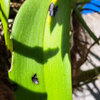My Fallen Phal
mrs.scott.12
10 years ago
Related Stories

HOUSEPLANTSHow to Grow Orchids Indoors
Orchids are the exotic aristocrats of the flower world and can make themselves comfortable in almost any home
Full StoryI am an orchid novice. Last year, my husband bought me a small phal orchid for our first anniversary. We had to be out of town for a few months during the summer, so we left it with a neighbor and gave them pretty simple instructions. When we came back, however, the blooms had fallen off, the spike was withered and the roots were overgrowing the pot, some were rotting. Luckily, the leaves were still green, so I pruned the spike, repotted it and have been carefully monitoring it for the last 8 months. Two old leaves turned yellow and fell off, and two new ones have grown in, which I took for a good sign. But there's still no new spike and the roots are looking pretty rough. Is it time to repot it again? Will the roots ever heal? Is it time to give up? Any advice appreciated! Thank you!



arthurm